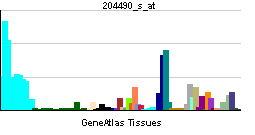CD44
| CD44 molecule (Indian blood group) | |||||||||||
|---|---|---|---|---|---|---|---|---|---|---|---|
 PDB rendering based on 1poz. | |||||||||||
| Identifiers | |||||||||||
| Symbols | CD44 ; CDW44; CSPG8; ECMR-III; HCELL; IN; LHR; MC56; MDU2; MDU3; MGC10468; MIC4; MUTCH-I; Pgp1 | ||||||||||
| External IDs | Template:OMIM5 Template:MGI HomoloGene: 508 | ||||||||||
| |||||||||||
| RNA expression pattern | |||||||||||
 | |||||||||||
 | |||||||||||
 | |||||||||||
| More reference expression data | |||||||||||
| Orthologs | |||||||||||
| Template:GNF Ortholog box | |||||||||||
| Species | Human | Mouse | |||||||||
| Entrez | n/a | n/a | |||||||||
| Ensembl | n/a | n/a | |||||||||
| UniProt | n/a | n/a | |||||||||
| RefSeq (mRNA) | n/a | n/a | |||||||||
| RefSeq (protein) | n/a | n/a | |||||||||
| Location (UCSC) | n/a | n/a | |||||||||
| PubMed search | n/a | n/a | |||||||||
|
WikiDoc Resources for CD44 |
|
Articles |
|---|
|
Media |
|
Evidence Based Medicine |
|
Clinical Trials |
|
Ongoing Trials on CD44 at Clinical Trials.gov Clinical Trials on CD44 at Google
|
|
Guidelines / Policies / Govt |
|
US National Guidelines Clearinghouse on CD44
|
|
Books |
|
News |
|
Commentary |
|
Definitions |
|
Patient Resources / Community |
|
Directions to Hospitals Treating CD44 Risk calculators and risk factors for CD44
|
|
Healthcare Provider Resources |
|
Continuing Medical Education (CME) |
|
International |
|
|
|
Business |
|
Experimental / Informatics |
Editor-In-Chief: C. Michael Gibson, M.S., M.D. [2]
The CD44 protein is a cell-surface glycoprotein involved in cell-cell interactions, cell adhesion and migration. It is a receptor for hyaluronic acid and can also interact with other ligands, such as osteopontin, collagens, and matrix metalloproteinases (MMPs). A specialized sialofucosylated glycoform of CD44 called HCELL is found natively on human hematopoietic stem cells, and is a highly potent E-selectin and L-selectin ligand. HCELL functions as a "bone homing receptor", directing migration of human hematopoietic stem cells and mesenchymal stem cells to bone marrow.[1]
This protein participates in a wide variety of cellular functions including lymphocyte activation, recirculation and homing, hematopoiesis, and tumor metastasis. Transcripts for this gene undergo complex alternative splicing that results in many functionally distinct isoforms, however, the full length nature of some of these variants has not been determined. Alternative splicing is the basis for the structural and functional diversity of this protein, and may be related to tumor metastasis. Splice variants of CD44 on colon cancer cells display the HCELL glycoform, which mediates binding to vascular E-selectin under hemodynamic flow conditions, a critical step in colon cancer metastasis. CD44 gene transcription is at least in part activated by beta catenin and Wnt signalling (also linked to tumour development). The protein is a determinant for the Indian blood group system.
- CD44 expression is an indicative marker for effector-memory T-cells. It is tracked with CFSE chemical tagging.
In addition, variations in CD44 are reported as cell surface markers for some breast and prostate cancer stem cells[2], and has been seen as an indicator of increased survival time in epithelial ovarian cancer patients.[3]
References
- ↑ Sackstein R et al. "Ex Vivo Glycan Engineering of CD44 Programs Human Multipotent Mesenchymal Stromal Cell Trafficking to Bone". Nature Medicine, 2008
- ↑ Li et al : "Beyond tumorigenesis : cancer stem cells in metastasis" Cell Research (2007) 17:3-14 doi:10.1038/sj.cr.7310118
- ↑ Sillanpää S, Anttila MA, Voutilainen K, Tammi RH, Tammi MI, Saarikoski SV, Kosma VM. [CD44 expression indicates favorable prognosis in epithelial ovarian cancer[1]. Clin Cancer Res. 2003 Nov 1;9(14):5318-24.
Further reading
- Günthert U (1994). "CD44: a multitude of isoforms with diverse functions". Curr. Top. Microbiol. Immunol. 184: 47–63. PMID 7508842.
- Yasuda M, Nakano K, Yasumoto K, Tanaka Y (2003). "CD44: functional relevance to inflammation and malignancy". Histol. Histopathol. 17 (3): 945–50. PMID 12168806.
- Sun CX, Robb VA, Gutmann DH (2003). "Protein 4.1 tumor suppressors: getting a FERM grip on growth regulation". J. Cell. Sci. 115 (Pt 21): 3991–4000. PMID 12356905.
- Assimakopoulos D, Kolettas E, Patrikakos G, Evangelou A (2003). "The role of CD44 in the development and prognosis of head and neck squamous cell carcinomas". Histol. Histopathol. 17 (4): 1269–81. PMID 12371152.
- Ponta H, Sherman L, Herrlich PA (2003). "CD44: from adhesion molecules to signalling regulators". Nat. Rev. Mol. Cell Biol. 4 (1): 33–45. doi:10.1038/nrm1004. PMID 12511867.
- Martin TA, Harrison G, Mansel RE, Jiang WG (2004). "The role of the CD44/ezrin complex in cancer metastasis". Crit. Rev. Oncol. Hematol. 46 (2): 165–86. PMID 12711360.
External links
- Indian blood group system at BGMUT Blood Group Antigen Gene Mutation Database at NCBI, NIH
- [3] Articles at IHOP.